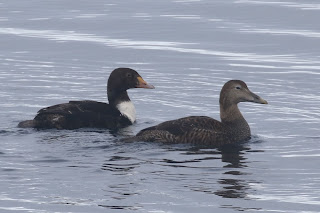One week into my 4-week visit to St. Anthony.
Life here revolves around the slob ice:
48 hours ago the slob ice was looming on the horizon and showed no threat of invasion. By this afternoon it had infiltrated the entire coast - the only patch of open water I could find was at Fishing Point, right in St. Anthony.
I arrived at the point in the mid-afternoon and was shocked to see two mega flocks of eiders totalling at least 13000 individuals!
Photos will never do justice to the number of ducks out there today - this photo alone surely includes over 5000 eiders! It was a very dramatic scene as the pack ice was slowly encroaching into this last open area and the eiders were frantically flying from one side to the other not knowing what to do or where to go next.
Eventually they flew out over the ice and ventured further South. The next 3+ days are calling for very windy conditions, including offshore winds which should open up the water again. It will be interesting to see if these eiders return.
The Strait of Belle Isle is totally locked in:
Bring on the polar bears!
The highlight so far has been this Gyrfalcon which was hunting Glaucous Gulls in St. Anthony harbour during the week:
A view of the harbour:
Pretty spectacular views of the night sky here:
The next main highlight was this male American Three-toed Woodpecker:
A long-awaited lifer!
Slob Gulls are the only gull species in the area:
Weird cloud/shadow formation this afternoon:
Posse of Guillemots:
...still planning to do a write up on last weeks guillemot observation.
Snow Bunting in habitat:
































































